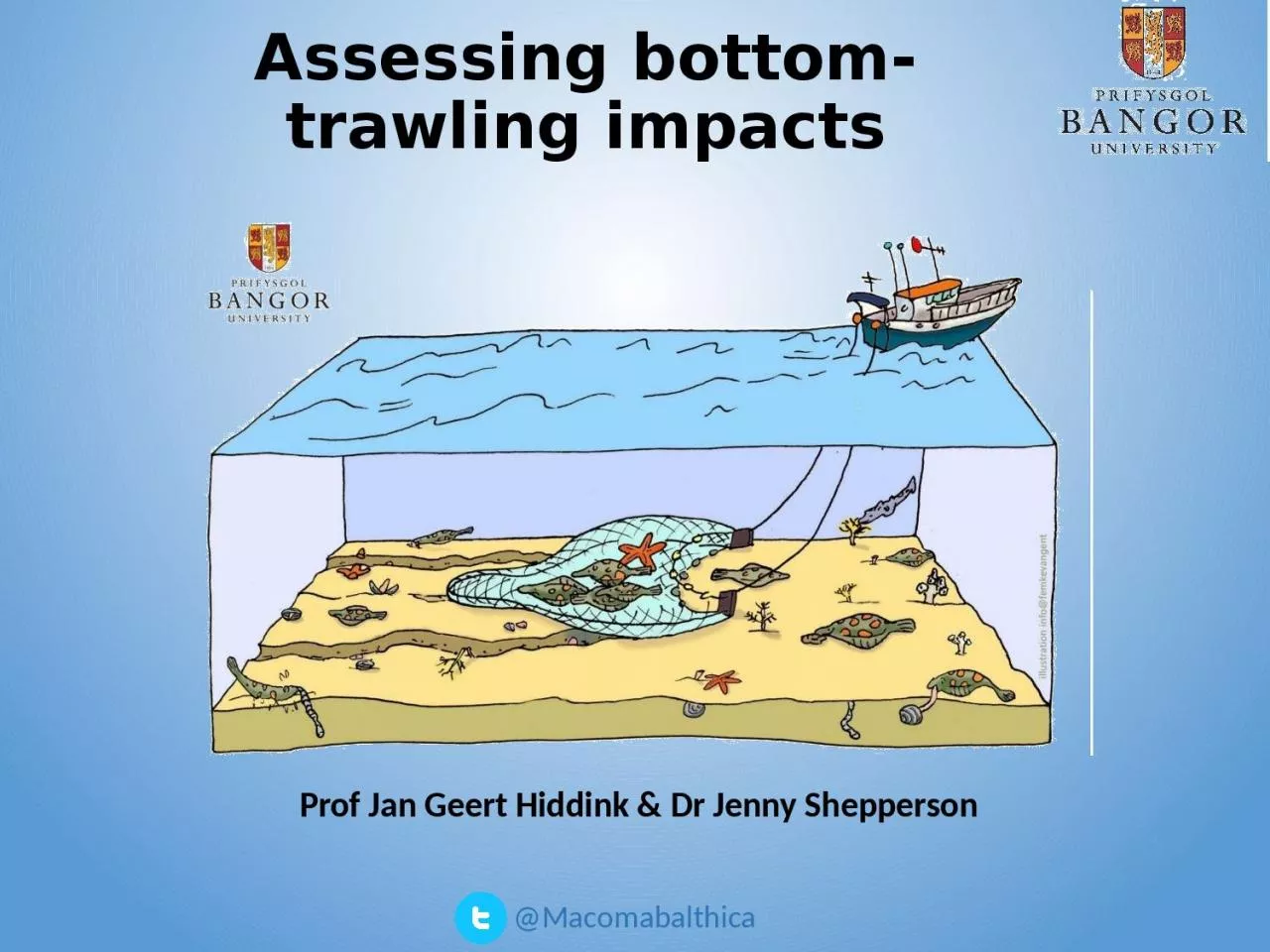

Assessing bottomtrawling impacts Macomabalthica Benthic community animals living in and on the sea bottom Food for fish sea birds marine mammals Bioturbation nutrient regeneration EU directives ID: 1018691
Download Presentation The PPT/PDF document " Prof Jan Geert Hiddink & Dr Jenny ..." is the property of its rightful owner. Permission is granted to download and print the materials on this web site for personal, non-commercial use only, and to display it on your personal computer provided you do not modify the materials and that you retain all copyright notices contained in the materials. By downloading content from our website, you accept the terms of this agreement.
1. Prof Jan Geert Hiddink & Dr Jenny SheppersonAssessing bottom-trawling impacts@Macomabalthica
2. Benthic community: animals living in and on the sea bottomFood for fish, sea birds, marine mammalsBioturbation: nutrient regenerationEU directives
3. Physical disturbance of seabed sediments by bottom trawls, by designBeam trawl / otter trawl / scallop dredgeImpact on benthosAbundanceBiomassProductionSpecies richness
4. Three steps to quantify impactsMap fishing activities & habitatsQuantify effects per gear and habitatAssessment
5. What is the science behind the approach?
6. Ecological effects on biotaDepend on ratio of …Fraction of organisms killed by a trawl pass: depletion = d : gear specificoverRate of population recovery = r : species and habitat specificTimeRelative Benthic Status
7. Ecological effects on biotaDepend on ratio of …Fraction of organisms killed by a trawl pass: depletion = d : gear specificoverRate of population recovery = r : species and habitat specificFast recoverySlow recoveryHigh trawl mortalityLow trawl mortality
8.
9. d: depletionfraction killed per trawl passDifferent gears have different effects on the seabedEcological effectsHiddink, J.G., Jennings, S., Sciberras, M., Szostek, C.L., Hughes, K.M., Ellis, N., Rijnsdorp, A.D., McConnaughey, R.A., Mazor, T., Hilborn, R., Collie, J.S., Pitcher, R., Amoroso, R.O., Parma, A.M., Suuronen, P. & Kaiser, M.J. (2017) Global analysis of depletion and recovery of seabed biota following bottom trawling disturbance. Proceedings of the National Academy of Sciences, 114, 8301–8306.HD = hydraulic dredgeTD = towed dredgeBT = beam trawlOT = otter trawl
10. Quantify sensitivity by longevityRecovery Rate Decreases
11. Different slopes for longevities
12. Example of sensitive and resilient communitiessensitive resilient
13. How can we apply the approach?
14. Maps of habitat typeMaps of where fishing takes placeInformation on depletion by gear typeWhat is the current status of each habitat type?[Relative Benthic Status]Recovery rates [proportion of animals in each longevity class]
15. Relative Benthic StatusProportion of biomass remaining relative to an un-impacted baselineRBS 1 = No depletionRBS 0 = Complete depletionRBS 0.6 = 60% of possible biomass remainingPitcher et al., (2017) RBS
16. Example output for NW Europe from ICES
17. Example Data LayersMap of fishing activityMap of habitats
18. Example Data LayersMap of fishing activityMap of habitatsDepletion rates of fishing gearsFraction of animals in each longevity class in each habitat
19. Map of fishing activityMap of habitatsDepletion rates of fishing gearsFraction of animals in each longevity class in each habitatExample Data Layers
20. Example Data LayersMean RBS = 0.93RBS score per habitat typeMuddy SandMean RBS = 0.76
21. Assessment data demandsFor DepletionFishing activity – VMSDepletion per gear type – quantified by Hiddink et al., 2018For RecoveryHabitat mapFraction of animals in each longevity class for each habitatcaptures effect of other disturbances (e.g. hypoxia, storms)Samples from unfished locations, biomass neededDefault available for NW Europe
22. Longevity distribution by habitatLongevity (yr)Relative biomassRijnsdorp, A.D., Bolam, S.G., Garcia, C., Hiddink, J.G., Hintzen, N., Kooten, T. van & Denderen, P.D. van (2018) Estimating the sensitivity seafloor habitats to disturbance by bottom trawling impacts based on the longevity of benthic fauna. Ecological Applications.
23. LimitationsIt is a model, only as good as simplifications & assumptionsResponse variable: relative community biomass. Correlates with biodiversity, ecosystem functioning.Bounds of usabilitySedimentary habitatsTowed bottom gearsRecruitment and dispersal not included
24. ConclusionsSimple approach based on latest scienceCombines theory with most robust available parameter estimatesLow demand for data layers
25. AcknowledgementsBENTHIS and Trawling Best PracticesRijnsdorp, Jennings, Kaiser, Pitcher, Hilborn, Bolam and othersThe work was funded by FP7 project BENTHIS (312088), DEFRA, NERC, Packard Foundation, Walton Foundation, American Seafoods Group U.S., Blumar Seafoods Denmark, Espersen Group, Glacier Fish Company LLC U.S., Independent Fisheries Limited N.Z., Nippon Suisan (USA), Inc., Pacific Andes International Holdings, Ltd., San Arawa, S.A., Sanford Ltd. N.Z., Sealord Group Ltd. N.Z., South African Trawling Association@Macomabalthica
26. Based on peer-reviewed scienceApproach used by ICES and MSCHiddink, J.G., Jennings, S., Sciberras, M., Bolam, S.G., Cambiè, G., McConnaughey, R.A., Mazor, T., Hilborn, R., Collie, J.S., Pitcher, R., Parma, A.M., Suuronen, P., Kaiser, M.J. & Rijnsdorp, A.D. (In press) Assessing bottom-trawling impacts based on the longevity of benthic invertebrates. Journal of Applied EcologyHiddink, J.G., Jennings, S., Sciberras, M., Szostek, C.L., Hughes, K.M., Ellis, N., Rijnsdorp, A.D., McConnaughey, R.A., Mazor, T., Hilborn, R., Collie, J.S., Pitcher, R., Amoroso, R.O., Parma, A.M., Suuronen, P. & Kaiser, M.J. (2017) Global analysis of depletion and recovery of seabed biota following bottom trawling disturbance. Proceedings of the National Academy of Sciences, 114, 8301–8306.Pitcher, C.R., Ellis, N., Jennings, S., Hiddink, J.G., Mazor, T., Kaiser, M.J., Kangas, M.I., McConnaughey, R.A., Parma, A.M., Rijnsdorp, A.D., Suuronen, P., Collie, J.S., Amoroso, R., Hughes, K.M. & Hilborn, R. (2017) Estimating the sustainability of towed fishing-gear impacts on seabed habitats: a simple quantitative risk assessment method applicable to data-limited fisheries. Methods in Ecology and Evolution, 8, 472-480.Rijnsdorp, A.D., Bolam, S.G., Garcia, C., Hiddink, J.G., Hintzen, N., Kooten, T.v. & Denderen, P.D.v. (2018) Estimating the sensitivity seafloor habitats to disturbance by bottom trawling impacts based on the longevity of benthic fauna. Ecological Applications, 28, 1302-1312.Sciberras, M., Hiddink, J.G., Jennings, S., Szostek, C.L., Hughes, K.M., Kneafsey, B., Clarke, L.J., Ellis, N., Rijnsdorp, A.D., McConnaughey, R.A., Hilborn, R., Collie, J.S., Pitcher, C.R., Amoroso, R.O., Parma, A.M., Suuronen, P. & Kaiser, M.J. (2018) Response of benthic fauna to experimental bottom fishing: a global meta-analysis. Fish and Fisheries, 19, 698-715.https://trawlingpractices.wordpress.com/